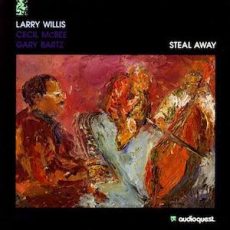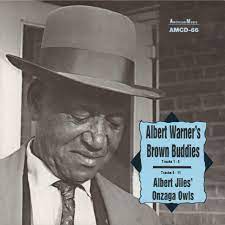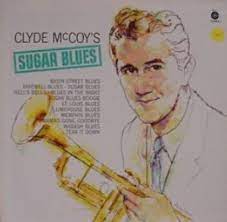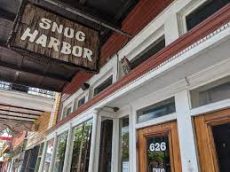
Requisites
Steal Away ~ Larry Willis | By Eddie Carter
This morning’s album from the library is Steal Away (AudioQuest Music AQ-LP 1009), a little-known release by pianist Larry Willis. It’s the first of two records Willis made for the label and his seventh as a leader. He’s joined on this date by Gary Bartz (tracks: A2, B1) on alto sax and Cecil McBee (A2, B1, B2) on bass. My copy is the 1992 U.S. Stereo audiophile album.
Side One opens with Valdosta Blues by Larry Willis, the first of three solo piano performances. The title comes from the city in Georgia and begins with the pianist’s tranquil introduction that builds to a breezy melody. His ensuing solo is a superb performance that moves easily toward an exquisite ending.
The title tune, Steal Away, is an American Negro spiritual by Wallace Willis. It has been with Larry since age three and was a favorite song of his Mother’s to sing. Willis opens with a delicately gentle introduction to Bartz and McBee’s very pretty melody. Gary’s opening solo is imaginative and confident. Larry follows with sweet notes that shine like the rays of the sun, and Cecil breezes blissfully through the closing statement into a gentle climax. Fallen Hero is Larry’s tribute to his brother Victor. He tells an intimate story that reveals his love and affection for his brother with reflective inspiration and tenderness.
“D” Bass-ic Blues by Cecil McBee starts with the bassist’s bowed introduction, setting up Bartz and Willis to join him in a medium-tempo theme. Larry eases into the first solo with joyful vitality. Gary keeps the ball rolling with a remarkable reading of melodic lines. Cecil lets his bass do the talking in the finale preceding the theme’s reprise and conclusion. Ethiopia is a hauntingly beautiful song by Larry Willis that’s presented as a duet with Cecil McBee. The duo starts with a tender melody, and then Larry’s opening statement is as gentle as a light summer rain. Cecil comes in next with a graceful interpretation ahead of the duo’s delicately pretty ending.
The Meaning of The Blues by Bobby Troup and Leah Worth is given a tasteful treatment by Willis. He makes the song his own in a solo showcase that’s warm and nostalgic, thoughtful and heartfelt into a serene finale of haunting dreaminess. Joe Harley produced Steal Away, Pierre M. Sprey was the recording engineer, and Bernie Grundman mastered the album. It’s a pure analog recording with a stunning soundstage that was pressed on 180 grams of audiophile vinyl and is a perfect demonstration record for any quality audio system. Larry Willis recorded twenty-one albums as a leader and many more as a sideman. If you’re a fan of piano jazz, I invite you to consider Steal Away by Larry Willis on your next record-shopping trip. It’s an excellent place to start your discovery of his music and a welcome addition to any jazz fan’s library!
~ Fallen Hero, Ethiopia, “D” Bass-ic Blues – Source: Album Liner Notes by Bill Kohihasse
~ American Negro Spirituals were songs that contained hidden codes and messages for enslaved people to escape on their own or through the Underground Railroad – Source: Wikipedia.org © 2023 by Edward Thomas Carter
More Posts: choice,classic,collectible,collector,history,instrumental,jazz,music,piano

Daily Dose Of Jazz…
Albert Warner was born on December 31, 1890, in the Tremé neighborhood of New Orleans, Louisiana. Though his father was a string bass player, he didn’t seriously pick up the trombone until he was twenty-two years old. Taking lessons from one of his half-brothers, Ulysses Jackson, as well as Arthur Stevens and Honoré Dutrey. His main influences in his youth came from hearing Freddie Keppard, Vic Gaspard, and Baptiste Delisle.
His first professional jobs were playing for dance bands, including those led by “Big Eye” Louis Nelson, Kid Rena, Wooden Joe Nicholas, Buddy Petit, and Chris Kelly. In 1932 Warner joined the Eureka Brass Band and remained a regular member of this group until his death in 1966. His musical interplay with Charles Sonny Henry in the Eureka band during the late 1940s and 1950s is remembered by many for its intricacy and beauty.
The early Forties saw Albert playing and recording with Bunk Johnson and George Lewis. He would record often throughout the 1950s and in the Sixties he could be found playing frequently at Preservation Hall, accompanying the Preservation Hall band on a number of tours with Kid Sheik and the Eureka Brass Band. He went on one Memphis tour with Billie and DeDe Pierce in 1965.
Warner left behind a number of sessions recorded and released by Commodore, Pax, Folkways, Atlantic, and American. The album Bunk Johnson 1942/1945, Eureka Brass Band and The Eureka Brass Band in Rehearsal, a number of recordings with Charlie Love, Peter Bocage with His Creole Serenaders and the Love-Jiles Ragtime Orchestra, released by American. He also appeared on other American label albums recorded by Punch Miller, John Casimir, Kid Sheik and appeared on Atlantic’s Jazz at Preservation Hall series.
Trombonist Albert Warner, who performed in the traditional and brass band genres, transitioned on September 10, 1966 in New Orleans.
More Posts: bandleader,history,instrumental,jazz,music,trombone

Daily Dose Of Jazz…
Stanley William Tracey was born on December 30, 1926 in Denmark Hill, South London, England. The Second World War disrupted his formal education, and he became a professional musician at the age of sixteen as a member of an Entertainments National Service Association touring group playing the accordion, his first instrument. He joined Ralph Reader’s Gang Shows at the age of nineteen, while in the RAF and formed a brief acquaintance with the comedian Tony Hancock.
Later, in the early 1950s, he worked in groups on the transatlantic liners Queen Mary and Caronia and toured the UK with Cab Calloway. By the mid-1950s, he had also taken up the vibraphone, but later ceased playing it. During the decade he worked widely with leading British modernists, including drummer Tony Crombie, clarinettist Vic Ash, the saxophonist-arranger Kenny Graham and trumpeter Dizzy Reece.
1957 saw Tracey touring the United States with Ronnie Scott’s group, and then became the pianist with Ted Heath’s Orchestra for two years at the end of the Fifties, including a US tour with singer Carmen McRae. Although he disliked Heath’s music, he gained a regular income and was well featured as a soloist on both piano and vibes. He contributed compositions and arrangements that stayed in the Heath book for many years.
He first recorded in 1952 with the trumpeter Kenny Baker, then recorded his first album as leader in 1958, Showcase, for English Decca label and Little Klunk in 1959. From 1960 until about 1967 Stan was the house pianist at Ronnie Scott’s Jazz Club in Soho, London, which gave him the opportunity to accompany many of the leading musicians from the US who visited the club. It is Tracey on piano that film viewers hear behind Rollins on the soundtrack of the Michael Caine version of Alfie. At the same time, he became active in Michael Horovitz’s New Departures project, mixing poetry performances with jazz, where the musicians interacted spontaneously with the words.
The early 1970s were a bleak time for Tracey. He began to work with musicians of a later generation, who worked in a free or avant-garde style. He continued to work in this idiom with Evan Parker at the UK’s Appleby Jazz Festival for several years, but this was always more of a sideline for Tracey, lasting 18 years that the festival existed. Stan formed his own label In the mid-1970s titled Steam, and a number of commissioned suites. These included The Salisbury Suite, The Crompton Suite and The Poets Suite.
He led his own octet from 1976 to 1985 and formed a sextet in 1979 and toured widely in the Middle East and India. He had a longstanding performance partnership from 1978 with saxophonist Art Themen, and his own son, drummer Clark Tracey. He shared the billing with arranger Gil Evans, Sal Nistico and Charlie Rouse. He went on to record over four dozen albums as a leader or co~leader, thirty as a sideman and on two soundtracks over the course of his career.
Pianist and composer Stan Tracey, who received the honor of the Officer of the Order of the British Empire (OBE) and appointed Commander of the Order of the British Empire (CBE), transitioned from cancer on December 6,
More Posts: bandleader,composer,history,instrumental,jazz,music,piano

Daily Dose Of Jazz…
Clyde Lee McCoy was born December 29, 1903 in Ashland, Kentucky to the family that feuded with the Hatfields. He began mastering the trumpet without formal instruction, after the family moved to Portsmouth, Ohio in 1912. This led him to perform regularly at church and school affairs. Five years later he was performing on the Cincinnati riverboats, and on the Mississippi River side-wheelers the Island Queen and the Bernard McSwain. He became one of the youngest musicians on the river at age 14.
In 1920, accepting an invitation for a small band to play at a Knoxville, Tennessee resort, his Chicago Orchestra rehearsed on the train and won the approval of George Whittle and the patrons of the Whittle Springs Hotel and Spa. After a two month engagement the band officially became known as the Clyde McCoy Orchestra.
In the late 1920s McCoy developed the signature “wah-wah” sound by fluttering a Harmon mute in the bell of his trumpet. In 1967, a similar effect was made for electric guitar with the introduction of the Vox Clyde McCoy Wah-Wah Pedal. Having nothing to do with the use or development of the pedal,Clyde’s name was only used for promotion.
Over the course of a seven decade career Clyde was based at various times in New York City, Los Angeles, California and Chicago, Illinois. He is best remembered for his theme song Sugar Blues, written by Clarence Williams and Lucy Fletcher, and also as a co-founder of Down Beat magazine in 1935. The song was performed with vocals by Bob Wills and his Texas Playboys, Fats Waller and Ella Fitzgerald.
Trumpeter and bandleader Clyde McCoy, who has a star on the Holywood Walk of Fame, transitioned on June 11, 1990 in Memphis, Tennessee.
More Posts: bandleader,history,instrumental,jazz,music,trumpet

The Jazz Voyager
The Jazz Voyager’s next destination is the Big Easy and a venerable jazz nightclub called Snug Harbor. Located in three rooms of a renovated 1800’s storefront situated in the Faubourg Marigny. The venue offers a dining room, a bar, and a music room.
Tonight I’ll be in the audience to witness once again the genius of New Orleans-bred saxophonist, clarinetist, composer and educator Victor Goines. He’ll be taking the stage as the guest bandleader of Snug’s “E-Day” Series. This is when musicians close to their late great Ellis Marsalis present their tribute concerts to his musical legacy on the night of the week that was Ellis’ Snug residency for over 30 years.
Snug Harbor features music 7 nights a week, primarily New Orleans modern jazz. The venue is located just outside the French Quarter, at 626 Frenchmen Street, New Orleans, LA 70116. For more information visit https://notoriousjazz.com/event/victor-goines.
More Posts: adventure,clarinet,club,genius,jazz,music,preserving,saxophone,travel




